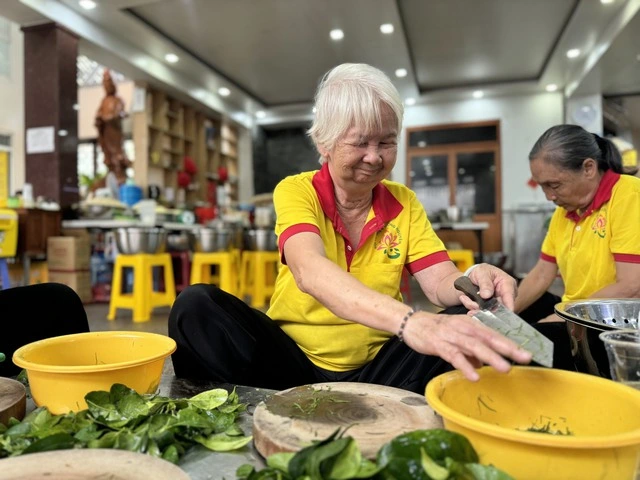Many Buddhists have come to Tuong Nguyen Pagoda in District 4, HCMC, these days to make mooncakes for underprivileged children to welcome the upcoming Mid-Autumn Festival on the 15th day of the eighth lunar month (September 17).
The kitchen of Tuong Nguyen Pagoda receives many Buddhists coming here every day to make the dough, slice lemon leaves, and prepare lotus seeds, melon seeds and cashew nuts to make and bake mooncakes. They can turn out about 2,000 mooncakes per day, weighing 250 grams each. It is estimated that 20,000-30,000 mooncakes will be made for disadvantaged children in this Mid-Autumn Festival.
Venerable Thich Minh Phu, the abbot of Tuong Nguyen Pagoda, told thanhnien.vn that organizers of the Mid-Autumn Festival for poor kids in rural and remote areas in Quang Binh, Binh Phuoc, Dak Nong, Vinh Long and Kien Giang provinces asked the pagoda to make free mooncakes for their events. The monk said all the ingredients have been chosen carefully to keep the mooncakes’ safety and hygiene: lotus seeds are bought from Hue City, cashew nuts from Binh Phuoc, and melon seeds from Quang Ngai.
Rooftop Vietnamese flag in Abyei Area
To celebrate the National Day (September 2), the Vietnamese sappers in Abyei Area, an area on the border between Sudan and South Sudan, have drawn a large flag covering 100 square meters on the roof of their base in Africa.
It took the sappers five days to paint the Vietnamese flag on the roof of the house facing the main gate. “The rooftop Vietnamese flag is a warm greeting to international visitors to the base, as well as a great pride of all of us, the Blue Berets on duty in Abyei Area in Africa,” a representative of the Vietnamese sappers told vnexpress.net.
Aside from drawing the rooftop flag, the Vietnamese peacekeepers also donated antibiotics, anti-inflammatories, vitamins, mouthwash, absorbent cotton and bandages, food and clothing to the Abyei Hospital, which receives about 160 patients a day, with only three doctors, four nurses and 11 volunteers.
The sappers have built two classrooms, 60 square meters each, for two schools in Abyei Area. They also repaired boats for the Mijak Community, whose people make their living by fishing on the river and move around by boat.
Rescuer of traffic accident victims at night
Nguyen Hoang Kim Ngan, 30, who lives in HCMC’s Thu Duc City, is the founder and head of the 911 Traffic Accident Rescue Team. With eight members, the voluntary team has been working in Thu Duc City and Di An City (Binh Duong Province) over the past seven years.
Ngan told plo.vn that her parents died of diseases long ago, and her elder sister died later after a traffic accident, adding that this was why she founded such a team to help traffic accident victims every night. The team’s eight members will be on duty in their spare time at night, while Ngan will always be at their gathering venue every night with her phone available 24/7.
Ngan said she is learning to become a physician at the Saigon Polytechnic College, whereas all other members have been trained and granted first aid certification by the Wellbeing Health Education Organization. The 911 Traffic Accident Rescue Team will inform local traffic police of traffic accidents, give first aid to victims before transferring them to the nearest health stations or hospitals. The team has assisted victims of over 300 traffic accidents so far this year.
Cat Ba langur population rises to 90
Fifteen Cat Ba langurs were born in the first half of 2024, taking the total population to over 90 – the highest count in around 100 years, reported the VnExpress news site.

The Cat Ba langur, also known as the Golden-headed langur (Trachypithecus poliocephalus), is a primate species endemic to the Cat Ba Archipelago, Cat Hai District, Hai Phong City. It is critically endangered and has the second-smallest population of any primate species in the world.
In 2000, the Cat Ba langur’s population fell to just over 40 individuals due to poaching. Afterwards, Cat Ba National Park collaborated with the Zoological Society for the Conservation of Species and Population (ZGAP) and Allwetterzoo Münster (Germany) to establish the Cat Ba Langur Conservation Project to prevent the extinction of this species. As a result, the number of langurs gradually increased.
Nguyen Quang Vinh, vice chairman of the Cat Hai District People’s Committee, said that the rise in the Cat Ba Langur population is a positive sign for primate conservation efforts in Vietnam and globally.









